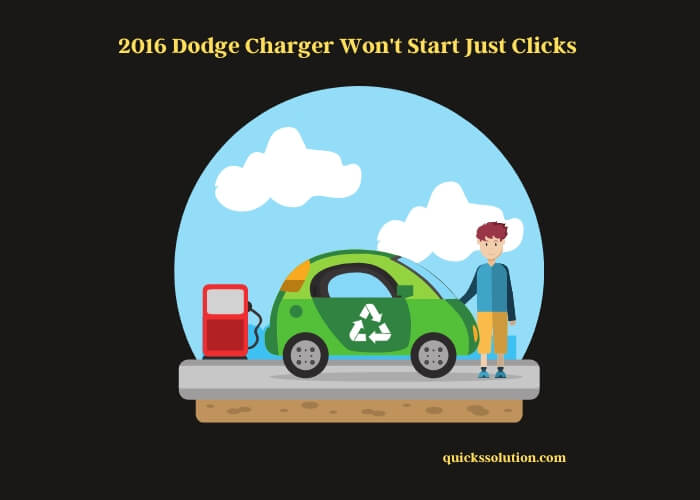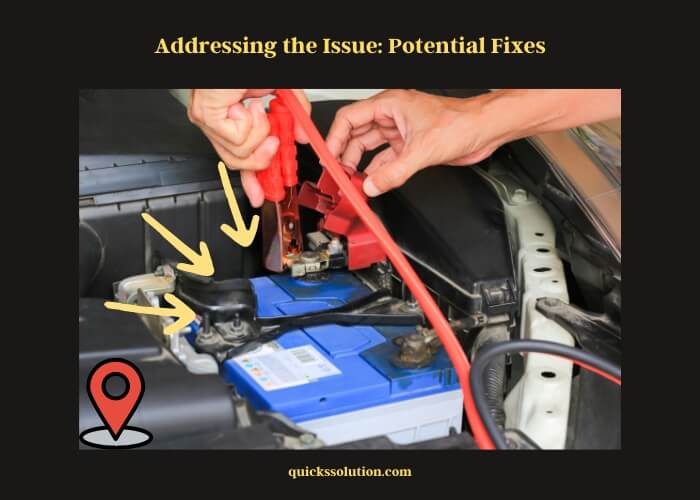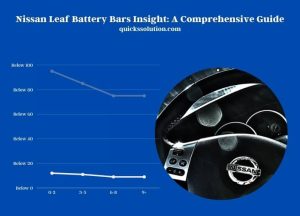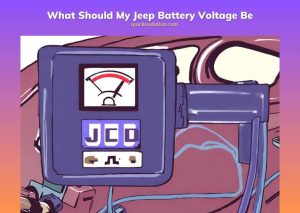Published on: July 21, 2023
Written by Amlan Roy / Fact-checked by Hashim Manna
Your 2016 Dodge Charger’s refusal to start and its accompanying clicking noise indicate a malfunctioning starter motor. It’s a common issue that might necessitate investigating related components such as the battery, battery cables, and alternator.
The push-button start, a modern convenience in the 2016 Dodge Charger, may fail to operate properly if the starter is defective. The starter’s role is vital in firing up your vehicle, and its failure can render your car useless. If you’re curious about the location of the starter, it’s generally situated near the rear of the engine or front of the transmission.

Your Charger might also produce a clicking noise during startup attempts if the starter is faulty. This annoying sound is often a clear sign of a worn-out starter motor. Your Charger won’t jump-start either in this scenario because the issue lies not with the battery but with the starter itself.
Sometimes, you may find that the brake is locked and the Dodge Charger won’t start. This can happen due to a variety of reasons, but a malfunctioning starter is often to blame. In such cases, a starter replacement becomes inevitable.
Replacing the starter of a 2016 Dodge Charger RT is a detailed process requiring a certain level of mechanical knowledge. It’s advisable to consult with a professional mechanic to ensure correct installation and avoid potential damage to your vehicle’s engine. Thus, when your Charger refuses to start and emits clicking noises, examining the starter should be among your first steps towards rectifying the problem.
The Sound of Silence: The Problem of a Non-Starting 2016 Dodge Charger
A common issue with the 2016 Dodge Charger is the clicking sound that emanates from the vehicle without it starting. This peculiar symptom can cause a fair share of frustration for Charger owners. The clicking sound is typically indicative of a bad starter motor, which may also point towards other underlying issues that need to be addressed.
The Core Mechanics: Starter Motor and Its Function
Starter Motor 101: Its Role in Vehicle Ignition
The starter motor is an integral part of your car’s ignition system. This component uses electrical energy from the car battery to create mechanical energy that turns the engine over, thereby initiating the ignition process.
Common Symptoms of a Failing Starter Motor
A failing starter motor is often betrayed by several symptoms. These can range from grinding noises and freewheeling (a whining noise from the engine) to smoke emanating from the engine and oil soak (the starter soaked in oil).
Dissecting Potential Causes of Clicking Sounds
The Role of Battery Power in Vehicle Ignition
The car battery is crucial to the proper functioning of the vehicle’s ignition process. If the battery lacks sufficient charge, it may fail to supply enough power to the starter motor, resulting in the dreaded clicking sound.
Battery Cables: Silent Troublemakers in Ignition Issues
Battery cables are the conductors that allow electricity to flow from the battery to the starter motor. Corroded, frayed, or loose cables can disrupt this power flow, leading to the non-starting issue.
The Alternator’s Role in Power Supply
The alternator is responsible for supplying electrical power to the vehicle’s components while simultaneously charging the car battery. A malfunctioning alternator may fail in supplying enough power for the ignition, causing the car not to start.
Ignition Switch Issues: An Overlooked Cause of Ignition Problems
The ignition switch, the component you insert your key into to start the car, can also be a source of problems. Faults in this switch can prevent the necessary electrical pathways from being completed, leading to the car not starting.
Troubleshooting 101: The Steps Involved
Diagnosing a Dying Battery: How to Proceed
Diagnosing a dying battery involves examining the physical state of the battery, checking for a bloated casing or corrosion around the terminals, and measuring the voltage using a multimeter. Anything below 12.2 volts could indicate a dying battery.
Identifying Faulty Battery Cables
Inspecting the condition of the battery cables is crucial. Look for signs of wear and tear, corrosion, or loose connections, all of which could indicate faulty cables.
Determining the Health of Your Alternator
To test your alternator’s health, use a multimeter to measure voltage across the battery terminals while the engine is running. If the reading is not between 13.7 and 14.7 volts, the alternator might be faulty.
Testing the Ignition Switch: The Right Approach
A professional mechanic should ideally test ignition switch issues using specialized diagnostic tools. Still, you can preliminarily check it by seeing if there are any issues with the dash lights or other electrical components when you turn the key.
Evaluating the Condition of the Starter Motor
To evaluate your starter motor’s condition, listen for any unusual noises when you turn the key. Also, check for any physical damage or oil leakage around the starter, as these may indicate issues.
Table: Symptoms and Potential Solutions
| Symptom | Potential Cause | Possible Solution |
| Clicking sound | Insufficient Battery Power | Battery Replacement |
| Clicking sound | Faulty Battery Cables | Cable Repair/Replacement |
| Clicking sound | Faulty Alternator | Alternator Repair/Replacement |
| Clicking sound | Faulty Ignition Switch | Ignition Switch Replacement |
| Clicking sound | Faulty Starter Motor | Starter Motor Replacement |
Addressing the Issue: Potential Fixes
The Process of Replacing a Dead Battery
Replacing a dead battery requires caution due to the potential for electric shocks. Disconnect the battery cables, remove the old battery, and install the new one, ensuring to connect the cables correctly.

Fixing Faulty Battery Cables: A Step-by-Step Guide
Repairing or replacing faulty battery cables may involve cleaning off corrosion or replacing the damaged cables with new ones, ensuring they are connected securely.
The Path to Fixing an Alternator
Fixing an alternator generally requires professional help due to its complexity. Mechanics can replace faulty parts or install a new alternator if necessary.
Ignition Switch Replacement: Is it Time for a New One?
Again, a professional should handle ignition switch replacement due to the intricacies involved. A skilled mechanic can ensure the new switch is installed correctly and securely.
Starter Motor Replacement: Is it The Only Solution?
If all other possibilities have been ruled out and the starter motor is the issue, replacing it might be the only solution. This task requires professional help due to the high voltage involved and the precision required.
Maintenance Measures and Useful Tips
The Role of Routine Maintenance in Preventing Ignition Issues
Regular servicing and check-ups can help prevent ignition issues. Timely detection and resolution of minor problems can prevent major breakdowns.
Lifespan of Your Starter Motor: Tips for Extension
Avoiding unnecessary short drives, ensuring your battery is in good condition, and avoiding cranking the engine unnecessarily can prolong your starter motor’s lifespan.
While this guide provides an overview of troubleshooting steps for a 2016 Dodge Charger that clicks but won’t start, always seek professional help for accurate diagnosis and repair.
FAQs
What Can Cause a Dodge Charger Not to Start?
The issue could stem from several factors such as a dead battery, faulty starter motor, corroded or damaged battery cables, a malfunctioning alternator, or issues with the ignition switch. Each scenario requires a different approach for resolution.
Why Does My Dodge Charger Produce a Clicking Noise?
A clicking noise often signals an issue with the starter motor. However, it may also hint towards problems with the battery, battery cables, or alternator. If these components can’t provide enough energy for the starter motor to initiate the engine, you’ll hear a clicking sound.
How can I troubleshoot my 2016 Dodge Charger if it won’t start and only makes clicking noises?
If your 2016 Dodge Charger won’t start and is making clicking noises, it could be due to a dead battery or a faulty starter. First, ensure that the battery connections are tight. If this does not solve the issue, try starting the car in dodge charger sport mode to see if it makes a difference. If not, it might be time to have a mechanic check it out.
Can a Faulty Starter Cause My 2011 Dodge Charger Not to Start?
Yes, a defective starter can indeed prevent your 2011 Dodge Charger from starting. The starter motor plays a critical role in igniting the engine, and if it’s dysfunctional, the engine won’t turn over.
Is the Starter for a 2017 Dodge Charger Different from Other Models?
Yes, the 2017 Dodge Charger might have a slightly different starter model compared to other years. Although many parts are standardized, slight variations can occur between different model years. It’s always best to check with your vehicle’s specific model and year.
Are There Common Problems with Dodge’s Push Button Start System?
Yes, like any vehicle component, the push-button start system in a Dodge Charger can develop issues over time. These can range from electronic glitches, issues with the fob, to more severe problems like a faulty ignition switch.
Does the Location of the Starter Matter in a 2011 Dodge Charger?
Yes, the location of the starter matters for maintenance and replacement purposes. In the 2011 Dodge Charger, the starter is typically located on the lower part of the engine, towards the rear. Knowing its location can facilitate faster and more efficient repairs.
What Is the Approximate Cost of a Dodge Charger Starter?
The price of a new starter for a Dodge Charger can range widely based on the model and year of your vehicle, but generally, it could be anywhere between $100 to $250 for the part alone. Keep in mind that labor costs for the installation will add to the total cost.
Read more:




